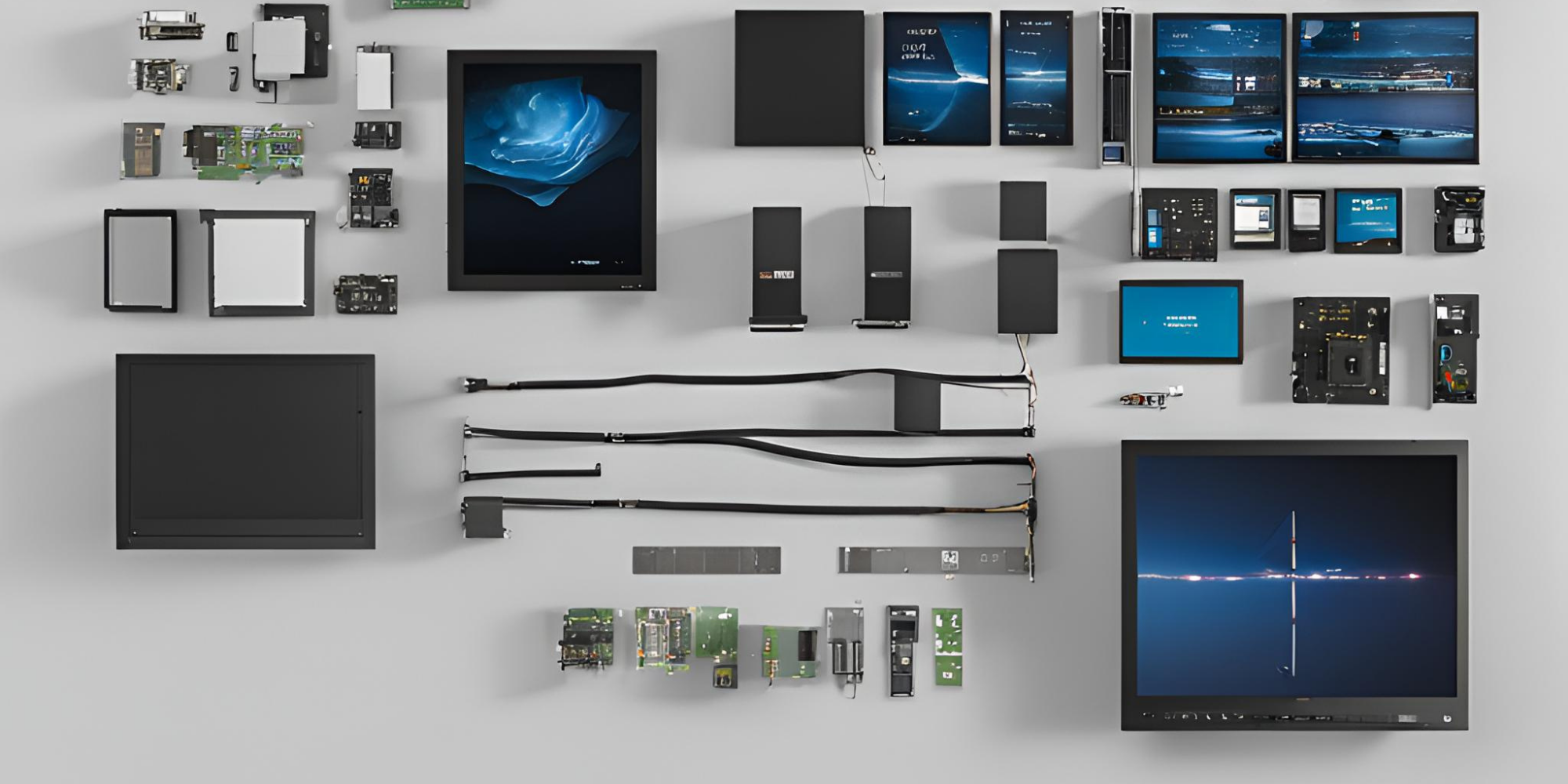
Digital signage has become ubiquitous in our visual landscape, offering an innovative way to communicate and engage with audiences across public spaces, retail environments, and corporate settings. From towering LED billboards that light up cityscapes to interactive kiosks in shopping malls, digital signage systems transform how messages are conveyed and experienced. The digital signage components are at the heart of these dynamic displays, a symphony of hardware and software working to deliver content that captivates and informs.
What are Digital Signage Components?
Digital signage components are the crucial elements that collaborate to create, manage, and display content on digital signs. These components encompass hardware and software elements, each fulfilling a specific role within the digital signage ecosystem. The paramount goal of these components is to deliver engaging and dynamic content to a targeted audience efficiently.
The hardware components of digital signage systems include the tangible parts necessary for displaying and distributing content. This category comprises digital screens, media players, and connectivity options. Digital screens, which vary in size and technology (such as LCD or LED displays), are tailored to different viewing environments and audience needs.
Why are Digital Signage Components Important?
Digital signage components are crucial for effective communication in public spaces. They enable businesses and organizations to share information, promotions, and updates in an attractive and timely manner. These components facilitate engaging audience interaction in real-time, making content seen and interacted with through features like touchscreens and social media integration. This transforms digital signage from a one-way communication tool into a dynamic platform for audience engagement.
For Effective Communication in Public Spaces
Digital signage components are pivotal in broadcasting information vividly and promptly in public areas. They facilitate the delivery of dynamic content that can swiftly adapt to the environment's context and the audience's specific needs. This adaptability ensures messages are seen as relevant and engaging to those who encounter them.
For Engaging Audience Interaction in Real-Time
The interactive capabilities of digital signage components transform passive viewing into active engagement. Incorporating elements like touchscreens, QR codes, and social media integration invites the audience to interact with the content in real time. This level of interaction fosters a deeper connection between the message and the viewer, making digital signage a powerful tool for engaging audiences.
What are the Primary Components of Digital Signage Systems?
The foundation of digital signage systems is built upon three key components: display screens, media players, and content management software. Each plays a vital role in the overall functionality and effectiveness of the system. Display screens serve as the visual interface, showcasing the content directly to the audience.
These screens vary in size and resolution, tailored to fit different environments and ensure optimal visibility from various viewing distances. Media players are the heart of the content delivery process and are responsible for storing and transmitting content to display screens. They follow predefined schedules or triggers to ensure timely and relevant content delivery.
Display Screens for Visual Output
Display screens are the visual cornerstone of digital signage systems, providing the essential canvas for messages to reach the audience. Available in various sizes and resolutions, these screens are meticulously tailored to ensure content is visible, whether viewed up close or from afar. The choice between indoor and outdoor screens hinges on their intended applicant, who effectively engages audiences and is signed to be robust and durable, capable of withstanding environmental elements.
Media Players for Content Delivery
Media players serve as the pivotal bridge, so choosing reliable media players is crucial in facilitating the seamless delivery of digital content to its intended audience. They store and stream digital signage content to display screens, operating according to a predefined schedule or responding to specific triggers. Media players' capabilities range from basic image and video playback to supporting advanced interactive and dynamic content, making them a versatile and indispensable component within the digital signage ecosystem.
Content Management Software for Operational Control
Content management software (CMS) is the operational heart of digital signage systems, providing users unparalleled control over content creation, scheduling, and distribution. This software enables users to effortlessly update and manage content across multiple displays from a centralized location, ensuring consistency and relevance. Equipped with design, scheduling, and analytics tools, CMS is indispensable for sustaining the effectiveness of digital signage, offering the necessary resources for dynamic and responsive content management.
How do Display Screens Affect Digital Signage?
Display screens are at the heart of digital signage, crucial in the visibility and effectiveness of the messages communicated. The size and resolution of these screens are pivotal, as they directly impact how content is perceived. Larger, high-resolution screens can deliver clearer and more engaging visuals, effectively captivating an audience from greater distances.
Furthermore, the distinction between indoor and outdoor screens significantly influences digital signage by determining the screen's durability and the environments in which the signage can operate efficiently. Indoor screens can prioritize detail and color accuracy. In contrast, outdoor screens are engineered to endure harsh conditions, ensuring that the message remains vivid and visible, regardless of weather or lighting conditions. Through these attributes, display screens critically shape the viewer's experience, underscoring their importance in the success of any digital signage strategy.
Size and Resolution for Clear Visibility
The size and resolution of display screens are paramount in determining digital signage's clarity and overall impact. Larger screens equipped with higher resolution enhance visibility and ensure that content captures attention and effectively communicates the intended message. High-resolution screens can display images and text with sharp detail, making intricate designs visible and legible from a distance.
Indoor vs. Outdoor Usage and Durability
The distinction between indoor and outdoor digital signage significantly influences display screens' durability and specific design requirements. Indoor screens prioritize high-quality content, benefiting from a controlled environment shielded from the elements. Conversely, outdoor screens are engineered to endure harsh weather conditions, including direct sunlight, rain, and extreme temperatures, while maintaining clear visibility.

What Role Does the Media Player Play in Digital Signage?
The media player serves as the heart of the digital signage system, acting as the pivotal content delivery mechanism. It is responsible for storing, processing, and transmitting digital signage content to the display screens, ensuring the content is presented accurately and at the correct times. Media players can handle a diverse range of content types, from basic images and text to complex videos and interactive applications, showcasing their versatility within digital signage networks.
Their functionality encompasses the scheduling of content playback and the capability to refresh displays with new content based on fixed schedules or specific triggers. This dynamic content management capability empowers businesses and organizations to maintain relevance and engagement in digital signage content. Through these critical roles, media players significantly enhance the effectiveness and adaptability of digital signage systems, underpinning seamless content delivery and sophisticated management.
What are the Latest Trends in Digital Signage Components?
The landscape of digital signage is continually evolving, with new trends that significantly enhance user engagement and content delivery efficacy. A key trend is the advent of interactive displays, which revolutionize how users interact with content. Through technologies such as touchscreens, gesture recognition, and augmented reality, these displays convert passive observers into active participants, elevating the digital signage experience to new heights of engagement and memorability.
Another pivotal trend is the shift towards 4K and 8K resolutions, dramatically improving image quality. This advancement ensures that digital signage content is more visually appealing and more captivating, making it far more effective at grabbing and holding the audience's attention. Furthermore, the rise of cloud-based content management systems represents a significant move towards more scalable and flexible digital signage solutions.
4K and 8K Resolutions for Superior Image Quality
The shift towards 4K and 8K resolutions marks a significant leap in the quality of digital signage imagery. These ultra-high resolutions deliver extraordinary clarity and detail, elevating the visual appeal of content to new heights. The enhanced sharpness and richness of 4K and 8K images captivate viewers, ensuring that the content attracts attention and retains it, thereby enriching the viewer's experience.
Cloud-based Content Management for Scalability
Cloud-based content management systems are transforming the scalability and flexibility of digital signage networks. These platforms facilitate remote management and real-time updates across widespread display networks, streamlining the content management process. By leveraging the cloud, digital signage operators can efficiently manage and distribute content, reducing the need for extensive on-site maintenance and enabling more dynamic content strategies.
What are the Challenges in Managing Digital Signage Components?
Managing digital signage components presents several challenges, including ensuring consistent content across multiple screens, dealing with technical issues and troubleshooting, and upholding security and data protection measures. Achieving content consistency across diverse displays, especially in expansive deployments, demands careful planning and coordination. This is essential to ensure that all screens display accurate and timely content, which is crucial for maintaining the effectiveness and reliability of the digital signage network.
Technical issues, ranging from hardware malfunctions to software glitches, represent another significant hurdle. These challenges can disrupt the smooth operation of digital signage, leading to downtime or the display of incorrect content. Such disruptions undermine the impact of digital signage and can negatively affect the reputation of the entity managing it.
Ensuring Consistent Content Across Multiple Screens
A key challenge in digital signage management is ensuring consistent content across a network of displays. This task demands high coordination to synchronize content updates across multiple screens, potentially spread over various locations. Achieving such consistency necessitates using advanced content management systems and precise scheduling strategies.
Technical Issues and Troubleshooting
Dealing with technical issues represents a significant operational challenge. These issues can range from hardware failures, like screen malfunctions, to software problems, such as bugs in the content management system. Establishing efficient troubleshooting mechanisms is crucial for quickly identifying and addressing these problems.
Security and Data Protection Measures
Reducing downtime and maintaining measures must be considered in the context of digital signage systems. These systems, which often integrate with broader network infrastructures and handle sensitive data, are potential targets for cyber threats. To safeguard the digital signage network, it is critical to implement measures that protect against unauthorized access, data breaches, and other security vulnerabilities.
Integrating Cutting-Edge Solutions for Seamless Digital Signage Management
As digital signage systems grow in complexity, integrating advanced solutions becomes essential for maintaining smooth operations. Leveraging cloud-based content management, enhanced security protocols, and automated troubleshooting tools can help overcome the challenges of managing digital signage components. These innovations streamline content delivery, ensure consistency, and protect your network from potential security threats. Are you interested in optimizing your digital signage management? Discover the benefits of Rise Vision, a leading cloud-based digital signage platform. Start your free digital signage design trial today!





